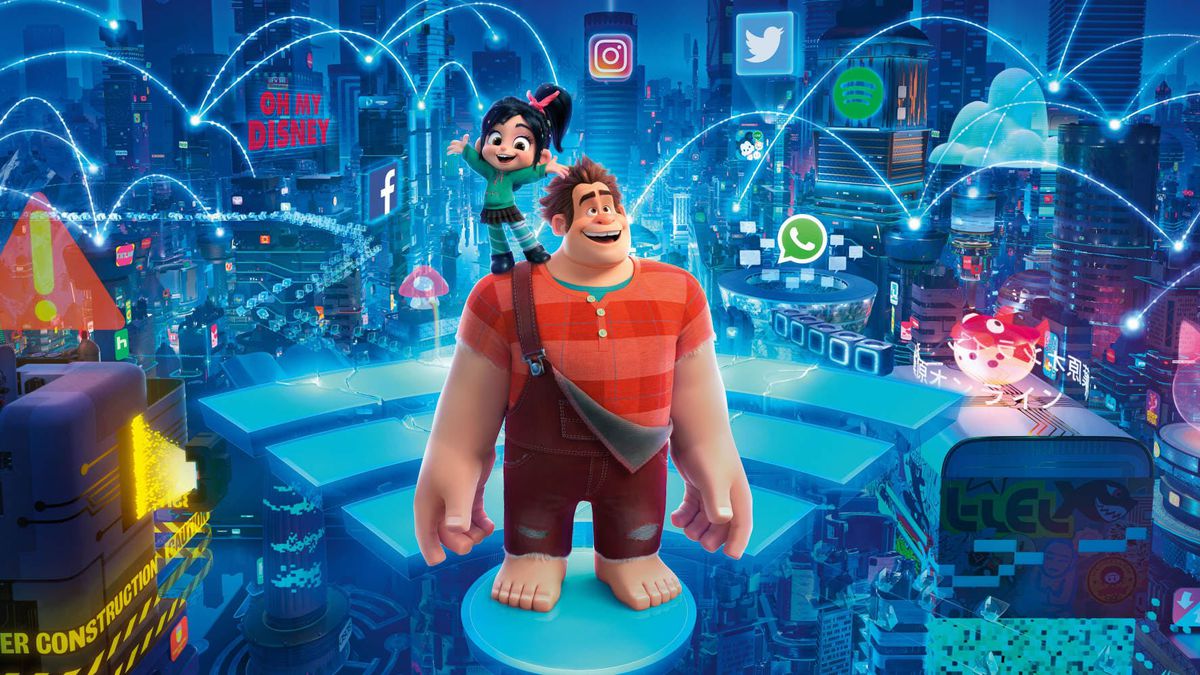Back in 2012, Disney found a powerful way to seemingly break the supposed ‘video game curse’ on Hollywood movies with Wreck-It Ralph. An original story that combined a Toy Story-inspired concept with the world of video arcades, Wreck-It Ralph told the story of a video game villain who was tired of being ‘bad’, and how he found his place with an unexpected new best friend, Vanellope Von Schweetz, a glitch character that isn’t supposed to technically exist. Following the events of the original Wreck-It Ralph, Ralph and Vanellope have since become inseparable, until that becomes threatened in this year’s long-awaited sequel, Ralph Breaks the Internet!
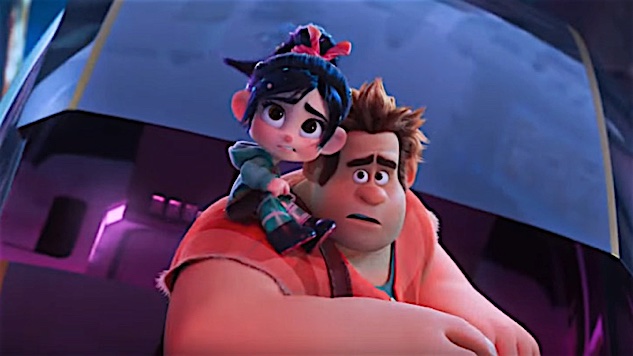
The title says it all, as Ralph and Vanellope, two vintage arcade game characters, discover the modern world on a trip to the internet. This might seem like a risky idea to some, since a very similar concept already crashed and burned last year with Sony Pictures Animation’s disastrous The Emoji Movie, but Ralph Breaks the Internet does at least have the advantage of coming from both a superior animation studio, and a superior established IP that already has one excellent movie to its name. It’s still true that Ralph Breaks the Internet doesn’t fully measure up to its predecessor, which had just a bit more novelty and emotional depth, but it’s nonetheless a strong sequel. There’s more of a blatant Disney touch, and more of a focus on self-referential satire, which might make Ralph Breaks the Internet become significantly more dated than its predecessor in a few years, but its humour is clever, and its heart is certainly big enough to be worthy of its oversized titular personality.
There’s a bit of an ensemble shift in Ralph Breaks the Internet, with many of the familiar supporting personalities from the first movie, most notably the citizens of both Ralph’s and Vanellope’s fictional arcade games, Fix-It Felix Jr. and Sugar Rush, respectively, relegated to mere bit parts this time around. We still get a return from the first movie’s voice actors even in the small parts, with Jack McBrayer returning to voice Fix-It Felix Jr., Jane Lynch returning to voice Sergeant Calhoun, and the same voiceover actors kept in place for real-world video game character cameos such as Sonic the Hedgehog and Tapper. Overall though, Ralph Breaks the Internet makes a great effort to introduce a whole new supporting cast for this follow-up, one that appropriately provides a whole new emotional perspective on the modern world for both Ralph and Vanellope, who have previously been cut off from it.
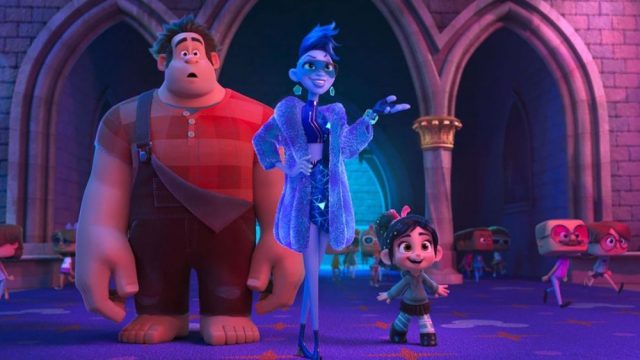
As much as the new supporting cast is quite exceptional however, Ralph and Vanellope remain the driving emotional force behind the storytelling, as their friendship faces a crisis of circumstance that ends up taking an unexpected new form as the movie progresses. John C. Reilly and Sarah Silverman remain highlights among the voice cast, as the good-natured Ralph and the ever-adventurous Vanellope find themselves in a whole new inter-connected world, after having to venture out into the internet to find a missing part for the Sugar Rush arcade machine. The new character arcs for both Ralph and Vanellope do a great job of building upon what was established in the first movie, taking both lead personalities on a new journey that doesn’t lead quite where you would initially expect it to, as the allures and dangers of the internet quickly make a strong impression on two characters that have lived in a previously self-contained video game ecosystem.
As much as Ralph Breaks the Internet goes all out with its new supporting actors as well, from Gal Gadot’s spunky online racer queen, Shank, to Alan Tudyk’s ever-exasperated KnowsMore search bar (yes, Tudyk is back in a different role, after voicing the original Wreck-It Ralph’s main antagonist, King Candy), to Taraji P. Henson’s haughty, but helpful social media tracker, Yesss, it’s also difficult to deny that the most impressive feat among the avalanche of cameos that are present throughout this sequel (I mean, it is an internet-themed movie, so a ton of celebrities naturally came out for the self-referential Disney jokes!), and what will probably make the biggest impression on audiences, is the much-publicized ‘Disney Princess reunion’ that occurs at a key point in the story. Most of the Disney princesses also remain voiced by their original actresses to boot (at least the ones that are semi-recent), from Ming-Na Wen returning as Mulan, to Anika Noni Rose returning as Tiana, to Idina Menzel returning as Elsa, to Jodi Benson returning as Ariel, and any other semi-modern example that you could name! The only exceptions are retro Disney princesses, Cinderella, Aurora and Snow White, with Cinderella and Aurora utilizing their updated Disney sequel voice actresses, while Snow White is actually voiced by this movie’s co-writer, Pamela Ribon. I can’t talk much about how the Disney princesses factor into the story without significant spoilers, but rest assured that they provide some of the movie’s best jokes and most memorable moments!
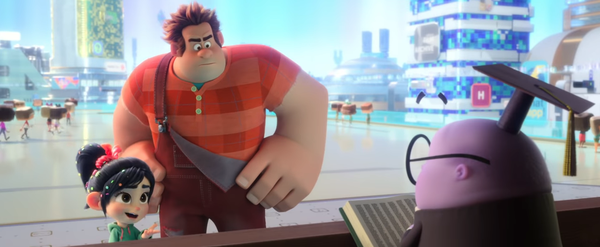
In fact, it’s tough to talk about the character arcs in general without significant spoilers, since Ralph Breaks the Internet benefits from would-be viewers not knowing much about the characters’ agendas going in. Many of the personalities in the movie will come to surprise audiences, creating an online world that isn’t often what it seems, which is leveraged to educate children in particular about online safety, but also while tying in with the first movie’s ideas of not judging people based on first impressions. In that latter respect especially, Ralph Breaks the Internet does feel very true to the character foundation of its predecessor, even with its heavily shifted focus and setting. It’s a different evolution for the characters than you would expect, but one that feels logical and rewarding, especially in a family-friendly story that isn’t afraid to tackle some themes without easy answers.
Ralph Breaks the Internet begins with a simple mission; Having Ralph and Vanellope venture into the internet to find a rare and expensive wheel controller for Vanellope’s Sugar Rush game, before Sugar Rush is unplugged, and its characters are left without a home. An innocent gesture by Ralph ends up being the catalyst to the threat behind Sugar Rush, which compels Ralph to join Vanellope on the mission to save her game, but the internet inevitably tests their friendship in unexpected ways. Of course, I say that, but you can imagine that the innocence of Ralph and Vanellope lends itself to a lot of predictable internet obstacles, from pop-up ads, to online auctions, to online gaming, among other modern technological milestones. This also includes a lot of tongue-in-cheek Disney product placement, like I said, even if the obvious sell-out elements are at least done with a wink and a good sense of humour.
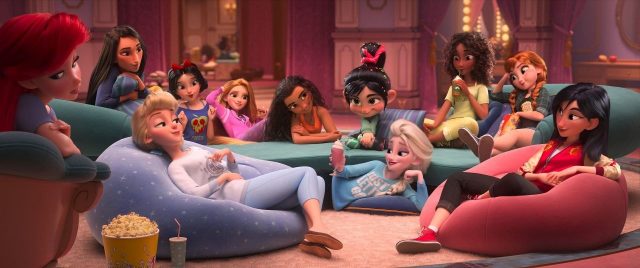
That being said however, it’s clear that Ralph Breaks the Internet was designed with heightened awareness at just how much of a following the original Wreck-It Ralph managed to earn. Wreck-It Ralph was a very uncertain prospect in 2012, but that also led to it feeling especially earnest and bold during the time of its release. Ralph Breaks the Internet doesn’t quite manage to have that same sense of novelty, despite its very commendable efforts to mix up the original movie’s formula and take it somewhere new. The internet humour can range a bit in quality throughout the storyline, but it will usually merit at least a chuckle, even if the movie doesn’t truly feel like it properly kicks into gear until Ralph and Vanellope actually make it online. The sluggish intro definitely merits some patience, especially from energetic children, but it is also true that the slower beginning of Ralph Breaks the Internet is at least made up for by the movie getting consistently better as it goes on, rather than worse.
Like I said, some of the internet humour can fluctuate a bit even when Ralph Breaks the Internet does hit its stride, with some of it being clever and hilarious while some of it is just tacky and awkward, but even the less effective internet-skewing moments aren’t enough to ruin a story that does manage to have a very heartfelt theme of connectivity and growing up behind it. This is definitely a sequel that took a while to put together, arriving a whole six years after its predecessor did, but it’s clear that the writers wanted to make sure that they got the overall spirit and themes behind this movie right. In that sense, it’s impossible to deny that Ralph Breaks the Internet is made with a ton of heart and passion, even if it does occasionally fall into the desire of going for the low-hanging fruit with its internet humour. Even then though, the climax and resolution of the movie end up coming together in a surprisingly profound and emotional way, providing an ultimate obstacle that is very creative and unpredictable, plus one that isn’t afraid to challenge children and adults alike in terms of how they perceive social interaction and human connection.
Original Wreck-It Ralph director, Rich Moore returns to direct this sequel, now sharing co-directing duties with the original Wreck-It Ralph movie’s writer, Phil Johnston as well. The combined efforts of Moore and Johnston appear to create a strong narrative compromise between honouring the spirit of the original movie, while taking the story in a huge new direction at the same time. The polish behind their direction is especially apparent throughout the depiction of the internet itself, which unfolds as a massive, buzzing hub of personality-filled icons, with all of whom being as obnoxious as they are eager to serve. There are some obvious references in the internet-themed humour, from the expected jabs at social media platforms like Twitter and Instagram, as well as the creative economies of sites like YouTube and Facebook, sometimes with the actual name licenses, and sometimes not. Thankfully though, Ralph Breaks the Internet still manages to provide a memorable and charming online world for audiences to explore, even if it’s one that does hit a few notes of predictable humour and commentary.
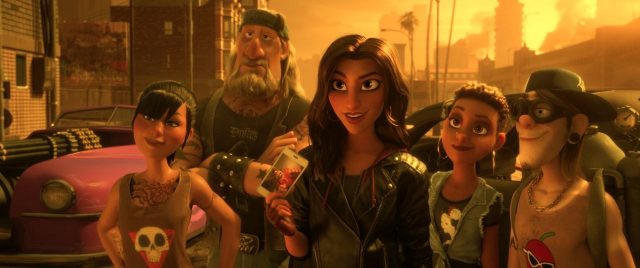
When Moore and Johnston really think outside the box however, Ralph Breaks the Internet quickly cements itself as one of the most unique and creatively ambitious animated movies to release this year! As I said, the scale behind the movie keeps steadily building and building with each passing moment, until it comes together in a climactic act that is both outrageous and surprisingly meaningful. Even when it’s putting its two leads’ friendship to the test however, Ralph Breaks the Internet doesn’t compromise its sense of likable, self-aware charm, despite the fact that some less forgiving viewers may take this as a proud, shameless declaration that this is a sell-out sequel for Disney. This element by the directors of poking fun at their own inspiration is especially evident during a pair of post-credits scenes as well, which lovably satirize Disney’s own corporate and fan culture, while adding a bit of self-aware trolling for good measure. There’s definitely no shortage of cleverness from either of the directors overall, who both seem to be fully aware of what’s great and what’s problematic in their big sequel idea, and are deciding to proudly lean into both angles to accentuate both the humour and the heart, which manages to work a lot more often than you would initially think.
Henry Jackman returns to compose the score to Ralph Breaks the Internet, which is overall pretty solid, even if it hits almost every note that you would expect in a movie with this theme, pun not intended. The catchy, synth-heavy tunes combine with old-fashioned Disney orchestral whimsy to mostly good effect, creating a movie soundtrack that feels true to its setting, while also being very true to the Disney formula, for better or for worse. The most unexpected point in the soundtrack comes by way of a surprise musical number about halfway through the movie, which is quite funny, and made to be intentionally awkward. Outside of this musical number, there’s also a tie-in single by Imagine Dragons, “Zer0”, which is very much unlike the band’s usual output, especially considering how cleaned-up and family-friendly the song obviously has to be. “Zer0” is alright, but I could give or take it, especially since that spoiler-heavy musical number that I won’t elaborate on delivers a song that is both more amusing and more memorable by comparison.
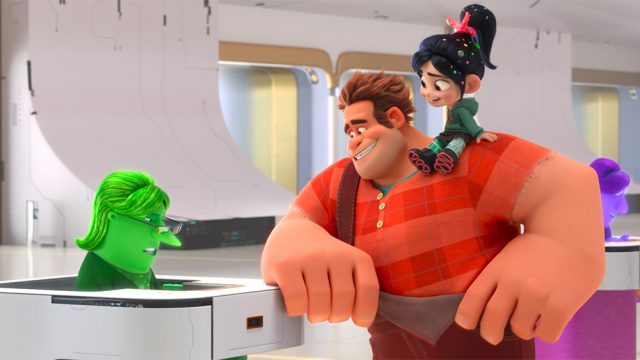
The rest of the audio work is, again, well-done, even if it hits all of the same beats that you would expect it to. The cartoon-y, fast-paced action sees an increase in scope now that it’s unfolding on the internet, and this is especially evident when Ralph and Vanellope make it to Shank’s online racing game, Slaughter Race. It’s a bit disappointing that the fun, video game-y sound effects from the first movie are given decreased emphasis in the sequel, since it no longer unfolds in a vintage arcade environment, but the new internet locations still find clever ways to make their own pleasant and lively audio cues. The audio presentation behind the first movie is just a bit more memorable, but the audio is still used well in this sequel, lending itself to the enhancement of some great jokes, as both Ralph and Vanellope inevitably end up lost in the internet’s many distractions. It’s all in good fun and perfectly agreeable for the more sensitive ears of children, without feeling too watered-down or flavourless for adults.
Unsurprisingly, the animation in Ralph Breaks the Internet is pretty fantastic throughout, particularly now that it gets to play with some of the heightened scale offered by the internet environments. There’s a bit less creativity to the overall worlds in contrast to the first movie, which had arcade settings with some more distinct and diverse charm, but the animation throughout the environments and personalities of Ralph Breaks the Internet is still well-detailed. It’s especially clever that the animation makes the arcade personalities appear simpler and less defined as well, while the characters behind modern internet platforms are much more ornate, detailed and lifelike in their visual design, nicely reflecting how Ralph and Vanellope are seen as lovably simple and sheltered folk within their new setting. The obstacles end up exuding more noticeable imagination than the cyberspace environments of the internet itself at times, but this still packs Ralph Breaks the Internet with plenty of personality and visual inspiration, especially when it’s able to make use of its internet humour to produce some truly wacky and unbelievable visual moments. I suppose that’s all the more easy to do when your only real competition with this modern internet world backdrop is The Emoji Movie, which isn’t so much a genuine rival as much as it is a bad idea from another studio that Disney essentially came in and fixed with Ralph Breaks the Internet.
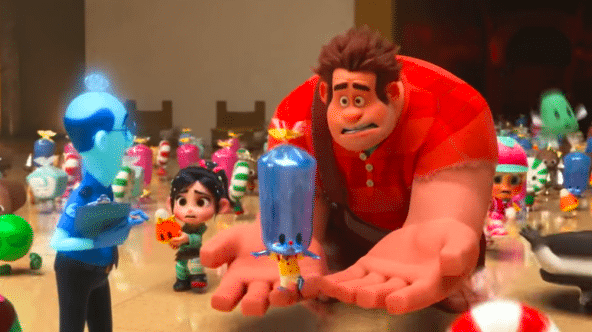
Regarding the 3D presentation, I did see Ralph Breaks the Internet in the 3D format, and while the 3D presentation was a little sharper in the first movie, it’s still pretty good in this sequel. The 3D best benefits the internet environments, which stretch with a noticeably greater sense of scale and immersion when paired with some 3D glasses, but there are also a few moments of ‘pop-out’ 3D, like the obnoxious 3D that was very common when this medium of filmmaking was first being pioneered several decades ago, which also feel like they’re mainly present to continue poking fun at the movie’s self-aware satire of modern Disney presentations. If you’d rather avoid these intentionally obnoxious 3D moments, you could always watch Ralph Breaks the Internet flat in 2D, and still experience a visually strong animated Disney presentation, though the handful of 3D jokes definitely don’t translate well to 2D, as you can imagine, where they become even more obvious and annoying in some respects. Frankly, your kids will probably have more fun with the 3D presentation anyway, and considering that it does manage to bump up the action and immersion to a noticeable degree, I would recommend seeing Ralph Breaks the Internet in 3D if that option is available to you, especially since that’s clearly the format that the filmmakers had in mind for it.
Ralph Breaks the Internet is occasionally burdened by its need to rely on modern pop culture and internet references in order to sell its sense of humour, but thankfully, this doesn’t often become a problem for what’s otherwise a very good sequel overall. The storyline may not have every ounce of novelty that the original Wreck-It Ralph boasted in 2012, but Ralph Breaks the Internet still finds new and interesting directions to take its established lead characters and story foundation, in turn creating a follow-up that feels fresh and creative, without betraying most of what made the original movie such a massive surprise hit six years ago. It’s also worth noting that many of Disney’s in-house sequels, especially the straight-to-DVD ones, have a very hard time comparing to their predecessors at all. On that basis especially, Ralph Breaks the Internet is a clear cut above the majority of most in-house Disney follow-ups, with the House of Mouse often having to rely on subsidiaries like Pixar and Marvel Studios to make truly worthwhile movie sequels.
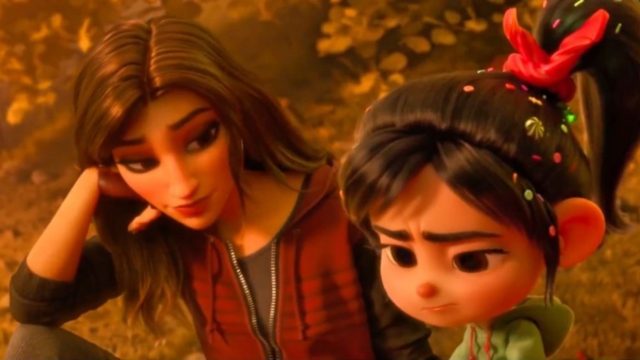
It’s true that the original Wreck-It Ralph remains the superior movie, but Ralph Breaks the Internet doesn’t significantly fall beneath it in terms of quality. This sequel may not reach the soaring heights of Pixar’s Incredibles 2 from this past Summer, but it’s still one of the best animated movies of 2018 by a sizable margin. It’s also worth appreciating that Disney and the filmmakers didn’t immediately rush out this sequel off the back of the original’s success, and did give it its proper time to fully develop into all that it was capable of being, much as Pixar was allowed to do with Incredibles 2 as well. Considering the onslaught of extensively disappointing November movies we got this year to boot, Ralph Breaks the Internet is a welcome gem that actually does manage to live up to its hype, even with its occasional need to pander to boilerplate internet examination. It’s hard not to miss those humble beginnings at Mr. Litwak’s arcade, but with Ralph and Vanellope embracing the chance to go bigger, it’s great to see that their sophomore romp didn’t come at the expense of all of that heartwarming spirit that the first movie worked so hard to build.

